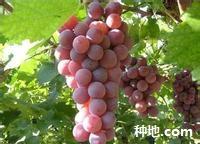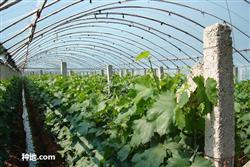How can black grapes be planted with high yield?

How to plant black grapes to get high yield? American black grape (black big grain and Rebel two varieties), panicle weight 500-700g, conical, grain weight 10-12g, peel thick, black, tough, pulp hard and crisp, juice purplish red, contains 18% soluble solids, extremely sweet, excellent quality. The growth days from sprouting to fruit ripening are about 160 days, and the fruit ripening period is in mid-late September. Causal grain is planted firmly, hard, does not drop grain, and is very resistant to storage and transportation. it is one of the excellent late-maturing varieties and is welcomed by producers. However, in the production, Heidi grape is extremely resistant and susceptible to diseases such as black pox and downy mildew. Extensive orchards are often destroyed because of serious diseases and poor economic benefits. The following is a brief introduction to the high-quality and high-yield cultivation techniques of Heiti grape. The main results are as follows: 1. the garden is built in neutral or slightly alkaline soil with loose soil, deep soil layer, groundwater level below 1 meter and good drainage (pH 6.0-7.5). The garden is cultivated by hedgerow with row spacing of 1 meter × 2 meters and 330 plants per mu. Before planting, dig a planting ditch with a depth of 80cm and a width of 100cm, apply 3000-4000 kg of organic fertilizer per mu, and plant it in spring after settling. Second, soil fertilizer and water management 1. Soil management adopts tree plate covered with grass, covering the ground with 15-20 cm thick wheat straw, corn straw and other weeds. The depression vineyard presses sand in the tree plate, which can reduce the occurrence of diseases. 2. Fertilizing base fertilizer, 4000 kg of high-quality ring fertilizer, 70 kg of superphosphate and 250kg of urea are applied per mu after fruit harvest. Top dressing. In the first year after planting, when the new shoot grew to more than 30 cm, urea was applied, 30-50 grams per plant; one month later, compound fertilizer, 50 grams per plant; and 30 grams of potassium dihydrogen phosphate in August. In the second year after planting, topdressing was carried out before flowering, after flowering and fruit expansion, mainly nitrogen fertilizer in the early stage and phosphorus and potassium fertilizer in the later stage. Water it. Combined with topdressing, it is necessary to ensure the water supply after fruit setting and fruit expansion period. The soil should be watered before freezing. Spray fertilizer on the leaves. 0.5-1% urea was sprayed in the budding stage, 0.3% urea and 0.3% borax was sprayed before flowering, various fertilizers were added in combination with spraying in the growing season, nitrogen fertilizer was mainly used in the early stage (0.3% urea), calcium fertilizer and its trace fertilizer were added, and phosphorus and potassium fertilizer was mainly used in the later stage (0.3% potassium dihydrogen phosphate). Third, plastic surgery and pruning. Adopt single-stem and double-arm V-shaped or fan-shaped pruning winter shears. Medium and short shoots are mainly pruned, 6-12 buds can be left in the extended branches of strong and prosperous main vines, 3-5 buds in middle branches, and 1-3 buds in weaker branches. The number of new shoots per mu is controlled at about 4000, which is reasonably covered with shelf surface, and the coring and binding are carried out in time; the fruiting branches are generally coring 5-7 days before flowering, and the coring degree is 6-8 leaves above the flower ear. Fourth, Flower and Fruit Management ⑴ removes excess inflorescences at the beginning of flowering, leaving 3000-4000 ears per mu. Each fruiting branch generally leaves 1 ear. ⑵ pinches the spike tip before flowering, generally removes 1 beat 4-1 beat 5, and removes the accessory spike. After setting the fruit, tidy up the ear and remove the overdense grains. Generally, there are about 60 fruits per ear. ⑶ fruit bagging. Bagging can promote fruit coloring, bright color, keep fruit powder and fruit surface clean, effectively control the occurrence of diseases, improve fruit quality, and is an effective way to produce high-quality pollution-free grapes. Bagging was carried out in mid-late June. Spray 75% chlorothalonil 600 times before bagging. Special grape bags can be selected, or homemade newspaper bags can be used. Tear open the bottom of the bag 7-10 days before harvest to promote coloring. Fifth, pest control of black grape diseases and insect pests are mainly downy mildew, black pox, powdery mildew, root cancer, red spider and so on. ⑴ dormant period. Clean up the orchard, clean up dead branches, fallen leaves, fruits, etc., concentrate on burning, and reduce the number of diseases and insect pests. ⑵ was sprayed with 5 Baomedo stone sulfur mixture before germination. ⑶ was sprayed with 70% mancozeb 1000 times plus 40% annihilation 4000 times before inflorescence separation. ⑷ was sprayed with 70% methyl topiramate 800 times before flowering. ⑸ sprays fungicides every 10-15 days after anthesis until the fruit is harvested. The agents used are: 50% Ruidu copper 600 times liquid, 64% poison alum 500 times liquid, 78% Cobo 600 times liquid, 70% ethyl phosphorus aluminum manganese zinc 600 times liquid, Pack 800 times liquid and 200 times lime half-dose Bordeaux liquid alternately, the disease prevention effect is better. 6. Overwintering against cold can safely survive the winter without burying soil to prevent cold in southern Shandong. In order to prevent the severe cold in winter, grass can be covered properly in the tree plate to prevent the cold. Northern Shandong and northern China need to bury soil to protect against cold. Click to see more grape planting techniques click to see more fruit planting techniques
- Prev

How to grow ruby seedless grapes?
How to grow ruby seedless grapes? What kind of planting method should I use? Ruby seedless grape has high fruit setting rate, uniform fruit, easy coloring, hard and crisp pulp, good flavor, early ripening and high yield, and strong adaptability. First, the basic situation planting test site is located in our district Huiguokou Village vineyard, the local frost-free period of 232 days, year.
- Next

How to use drip irrigation in greenhouse vineyard?
How to use drip irrigation in greenhouse vineyard? Drip irrigation is the most ideal technology for grape irrigation in greenhouse. It has the advantages of water saving, increasing production, cooling, labor saving and high efficiency. First, simple drip irrigation production: build a storage tank with a capacity of 3-5 cubic meters and a height of 1-3 meters at the head of the shed, and install gate valves and gate valves at the outlet of the pool.
Related
- Moge, come on! The staff of the peasant association in the producing area of cantaloupe were frightened when the crowd gathered.
- Causes and Solutions of low Fruit setting rate of Apple
- Symptoms and control measures of passion fruit virus disease
- Fruit growing lesson: how do apple orchards keep high yields?
- Can you build orchards in the mountains? What are the pros and cons?
- How to manage the coloring period of Crisson grape?
- This paper introduces the processing technology of two kinds of fig products.
- How much is a month for retired teachers in rural areas by 2020?
- How can strawberry planting increase sugar content? We should pay attention to management in many aspects.
- What are the cultivation techniques on how to improve the yield of golden fruit?

